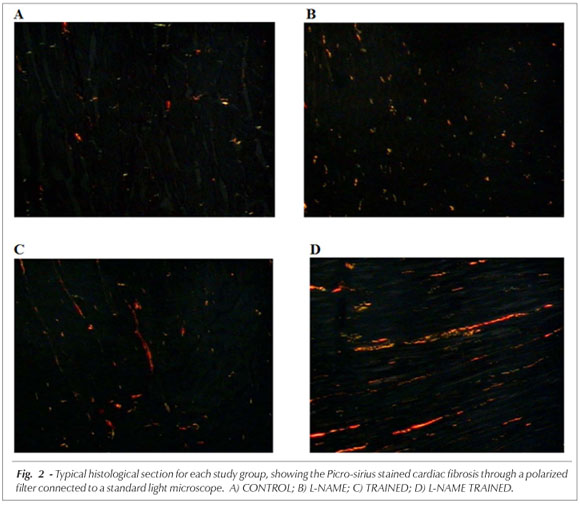OBJECTIVE: The objective of the present study was to evaluate cardiac tissue adaptations in rats submitted to aerobic training after nitric oxide (NO) synthesis blockade. METHODS: The animals (n=48) were divided into four groups: sedentary (CONTROL group); hypertensive after administration of NG-nitro-L-arginine methyl ester for 7 days (L-NAME Group); trained for 8 weeks through swimming exercises (TRAINED Group);trained and treated with L-NAME during the last week (L-NAME TRAINED Group). All the animals were submitted to the experiment procedures for blood pressure (BP) readings and cardiac morphometric evaluation. RESULTS: In comparison to the other groups, the L-NAME and L-NAME TRAINED groups were hypertensive (p<0.05); however, BP elevation in the L-NAME TRAINED group was significantly lower than the L-NAME group (p<0.05). The heart weight indexes for the TRAINED and L-NAME TRAINED groups were higher than the CONTROL and L-NAME groups (p<0.05). Also they had presented higher rates of macroscopic cardiac area and cardiac fibrosis in relation to the rest (p<0.05); comparisons revealed that the values for the L-NAME TRAINED group were significantly higher (p<0.05) than the others. CONCLUSION: Short term NO synthesis blockade in sedentary animals induced hypertension but did not cause cardiac hypertrophy. In the trained animals, the inhibition of NO synthesis attenuated hypertension, induced cardiac hypertrophy and significantly increased myocardial fibrosis, indicating that NO plays an important role in cardiac tissue adaptations caused by aerobic exercise.
Hypertension; exercise; nitric oxide; cardiomegaly; endomyocardial fibrosis



